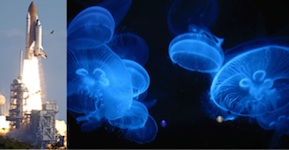DAYTONA BEACH, Fla. -- When the purple flags are being flown along the World's Most Famous Beach, they're not for a Barney the dinosaur birthday party. The flags are a warning to be alert about jellyfish -- those nearly invisible critters that blend in with the soapy surf and sometimes wash up along the shore.
Though they may be cool to look at, their sting is far less pleasant. And they have certainly made their presence felt to hundreds of beach goers in the last week, up and down Volusia County's nearly 50 miles of beaches.
There were 63 stinging victims on Tuesday, on top of some 200 in the seven previous days, according to beach patrol officials.
"We believe they are the Moon Jellys," Senior Captain Tamra Marris of the Volusia County Beach Safety Ocean Rescue told Headline Surfer. "We are advising people to pay attention to the beach condition flags. When we fly purple, then that is an indication there are jellyfish in the water."
"We believe they are the Moon Jellys," Senior Captain Tamra Marris of the Volusia County Beach Safety Ocean Rescue told Headline Surfer. "We are advising people to pay attention to the beach condition flags. When we fly purple, then that is an indication there are jellyfish in the water."
Marris said lifeguard are treating the stings with white vinegar, adding, "We have not had any transports to the hospital. The stings are occurring throughout the county beaches."
The coloration of a moon jelly often changes depending on its diet. If the jelly feeds extensively on crustaceans, it turns pink or lavender. An orange tint hints that a jelly's been feeding on brine shrimp.
These alien-looking creatures are named for their translucent, moonlike circular bells. Instead of long, trailing tentacles, moon jellies have a short, fine fringe (cilia) that sweeps food toward the mucous layer on the edges of the bells. Prey is stored in pouches until the oral arms pick it up and begin to digest it.
 DID YOU KNOW?
DID YOU KNOW?